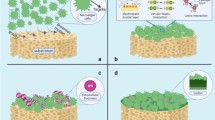Abstract
The accumulation and volatilization of mercury by non-immobilized and immobilizedChlorella emersonii have been studied in batch culture systems. Reduction in the mercury concentration in the growth medium by non-immobilized cells was highly dependent on inoculum density, whilst reduction in mercury concentration by immobilized cells was rapid at all inoculum densities. Mercury accumulation by immobilized cell biomass was significantly greater than by non-immobilized cells with 106 and 105 cells bead−1 or ml−1. Volatilization of mercury by non-immobilized cell systems was greatest at higher inoculum densities, whereas more mercury was volatilized from immobilized cell systems at lower inoculum densities, and was greatest with unstocked alginate beads. Thus, in immobilized systems, mercury removal from solution is complex and involves mercury accumulation by the cells and volatilization by the matrix and cells. Further studies of mercury accumulation and volatilization by unstocked immobilization matrices revealed that agarose volatilized much less mercury than alginate or agar. The precise mechanism of mercury volatilization by alginate remains unclear, though it is thought to be a chemical effect.
Similar content being viewed by others
References
Aksu Z, Kutsal T (1987) The usage ofChlorella vulgaris in waste water treatment containing heavy metal ions. Proc. 4th Eur. Cong. Biotech 2: 80–83.
Ben-Bassat D, Mayer AM (1977) Reduction of mercury chloride byChlorella: evidence for a reducing factor. Physiol. Pl. 40: 157–162.
Chevalier P, De La Noüe J (1985) Wastewater nutrient removal with microalgae immobilized in carrageenan. Enzyme Microb. Technol. 7: 621–624.
Darnall DW, Green B, Henzl MT, Hosea JM, McPherson RA, Sneddon J, Alexander MD (1986) Selective recovery of gold and other metal ions from algal biomass. Environ. Sci. Technol. 20: 206–208.
De Filippis LF (1978) The effect of sub-lethal concentrations of mercury and zinc onChlorella IV Characteristics of a general reducing enzyme system for metallic ions. Z. Pflanzenphysiol. 86S: 339–352.
De Filippis LF, Pallaghy CK (1976) The effect of sub-lethal concentrations of mercury and zinc onChlorella III Development and possible mechanisms of resistance to metals. Z. Pflanzenphysiol. 79S: 332–335.
D'Itri FM (1972) The environmental mercury problem. Chemical Rubber Company Press, Cleveland, Ohio, 5–68.
European Community (1982) Directive on limit values and quality objectives for mercury discharges by the chloralkali electrolysis industry (82/176/EEC). Off. J. Eur. Comm. L81: 29–33.
European Community (1982) Directive on limit values and quality objectives for mercury discharges by sectors other than the chlor-alkali industry (84/156/EEC). Off. J. Eur. Comm. L74: 49–53.
Foster TJ (1987) The genetics and biochemistry of mercury resistance. CRC Critical Reviews in Microbiology 15: 117–140.
Jensen S, Jernelöv A (1969) Biological methylation of mercury in aquatic organisms. Nature 223: 753.
Khummongol D, Canterford GS, Fryer C (1982) Accumulation of heavy metals in unicellular algae. Biotech. Bioeng. 25: 2643–2660.
Kuyucak N, Volesky B (1988) Biosorbents for recovery of metals from industrial solutions. Biotech. Lett. 10: 137–142.
Macka W, Wihlidal H, Stehlik G, Washüttl J, Bancher E (1978) Metabolic studies of Hg 203 onChlamydomonas reinhardi Experientia 15: 602–603.
Nakajima A, Horikoshi T, Sakagushi T (1982) Recovery of uranium by immobilized microorganisms. Eur. J. Appl. Microbiol. Biotech. 16: 88–91.
Nichols HW (1973) Growth media-freshwater. In: Stein JR (ed.). Handbook of Phycological Methods. Cambridge University Press, Cambridge, 7–24.
Pore RS (1984) Detoxification of chlordecone poisoned rats withChlorella andChlorella derived sporopollenin. Drug Chem. Toxicol. 7: 57–71.
Robinson PK, Goulding KH, Mak AL, Trevan MD (1986) Factors affecting the growth characteristics of alginate-entrappedChlorella. Enzyme Microb. Technol. 8: 729–733.
Robinson PK, Reeve JO, Goulding KH (1989) Phosphorus uptake kinetics of immobilizedChlorella in batch and continuous-flow culture. Enzyme Microb. Technol. 11: 590–596.
Shieh YJ, Barber J (1973) Uptake of mercury byChlorella and its effect on potassium regulation. Planta 109: 49–60.
Wilkinson SC, Goulding KH, Robinson PK (1989) Mercury accumulation and volatilization in immobilized algal cell systems. Biotech. Lett. 11: 861–864.
Author information
Authors and Affiliations
Rights and permissions
About this article
Cite this article
Wilkinson, S.C., Goulding, K.H. & Robinson, P.K. Mercury removal by immobilized algae in batch culture systems. J Appl Phycol 2, 223–230 (1990). https://doi.org/10.1007/BF02179779
Received:
Revised:
Accepted:
Issue Date:
DOI: https://doi.org/10.1007/BF02179779




